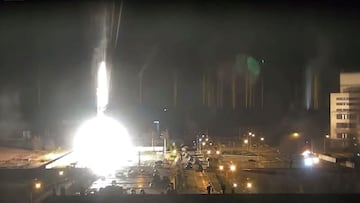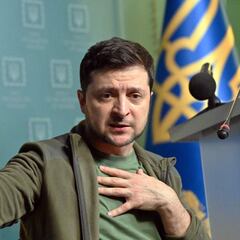Could the Zaporizhzhia nuclear power plant fire be worse than the Chernobyl explosion?
The Russian military launched a sustained attack on the site, setting an area around the third reactor on fire and sparking concern of a major disaster.


In the early hours of Friday, 4 March in Ukraine local authorities confirmed that the Zaporizhzhia nuclear power plant in the southeast of the country was on fire after coming under heavy fire from Russian forces.
Dmytro Orlov, mayor of nearby Enerhodar, wrote on Facebook: "A threat to world security!!! As a result of relentless shelling by the enemy of the buildings and blocks of the largest nuclear power plant in Europe, the Zaporizhzhia nuclear power plant is on fire!!!"
Fire fighters were dispatched to control the blaze but Russian troops continued to target the area. Ukraine's Foreign Minister Dmytro Kuleba called on Russia to “immediately cease the fire, allow firefighters, establish a security zone."
The New York Times verified videos from the firefight at Europe's largest power plant in Zaporizhzhia, Ukraine. It appears to show a line of military vehicles shooting at buildings inside the complex resulting in fires breaking out.
— Brenna T. Smith (@brenna__smith) March 4, 2022
Read more here: https://t.co/IqtD7ydd1R pic.twitter.com/TTQ8XFUot0
Kuleba continued by warning that the fire could be ten times worse than Chernobyl, the 1986 explosion at a nuclear power plant in northern Ukraine which is the most catastrophic nuclear disaster in human history.
However the head of the military administration in the Zaporizhzhia region has since confirmed: "The director of the plant said that the nuclear safety is now guaranteed.”
What is the situation in Zaporizhzhia?
Within the past hour there have been various reports from local sources describing the situation in the area and the continued attack of Russia troops. Orlov decried the “continuous enemy shelling of buildings and units of the largest nuclear power plant in Europe.”
In a short video message he urged Russia to halt the firing to allow emergency response teams to secure the area. However Russian troops appeared to make a concerted effort to target the nuclear plant and it seems unlikely that they would choose to allow Ukraine to make the area safe.
While the situation is incredibly serious, initial reports suggest that the fire will be much less dangerous that the Chernobyl disaster. The plant includes six nuclear power units, only one of which was operating. The third power unit is the one most likely to be affected by the shooting and it was disconnected from the unified energy system, at the time.
Appreciate that nuclear experts and active watchers are speaking out and echoing that the nuclear reactors at Zaporizhzhia are NOT likely to explode in the way Chernobyl did - it will be bad, but a different bad.
— Claire Wählen (@Claire_Wahlen) March 4, 2022
In a Telegram post in response to the fire, Ukrainian State Emergency Service reported: “Radiation and fire safety conditions at nuclear power plants are within normal limits. Fire condition at the NPP is normal.”
Experts generally agree that the risk to human life in such a situation is incredibly nuanced and based on a number of factors. Mariana Budjeryn is a Ukrainian expert on nuclear energy at Harvard University’s Belfer Center and has spoken to The Guardian about the Zaporizhzhia power plant.
“Saying that a reactor building is hit doesn’t tell us much, because the most vulnerable [part of] this is the electricity and water supply,” she said.
Related stories
“If the core explodes, there’s hope that the confinement chamber will capture the radiation from release into the environment. Confinement chambers are designed with withstand some level of impact, even bombing.”
For now it appears that a major crisis has been averted but the continued Russian bombardment of nuclear sites makes the prospect of catastrophe increasingly likely.

